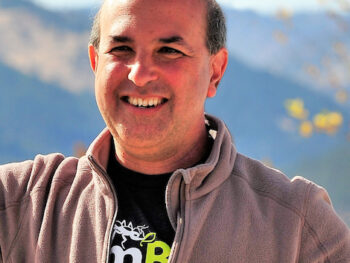Teachable Moments Series

How an abundance of seaweed helps students explore ecological principles
Christopher Columbus is often credited with naming the subtropical gyre of the North Atlantic Ocean the Sargasso Sea. I prefer to believe it was one of sailors accompanying him who coined the name. (Columbus, after all, was not well known for the accurate naming of things.) Regardless, according to this legend, the sea was named for an abundant seaweed whose gas-filled sacks reminded the crew of the small grapes—“salgazo”—of their homeland, Portugal. These air sacks allow the brown macroalgae, which is now known as Sargassum, to float atop the ocean where it serves as critical habitat for fish, sea turtles, and all manner of marine life.
Given the scarcity of nutrients in the open ocean, the algae’s abundance is surprising. Nevertheless, satellite imagery has documented an annual bloom that extends from West Africa to the Gulf of Mexico which can contain more than 20 million metric tons of biomass. Since 2011, the belt has been growing. In most years, the algae floats in small clumps scattered across the sea, but occasionally it accumulates in large rafts that are washed ashore by the prevailing currents. The result can be spectacular – in past years, beaches from Mexico to Florida have been blanked by mounds of rotting seaweed, sometimes as much as six feet tall.
As any ecologist knows, the decomposition of this much biomass is bound to have repercussions. Huge quantities of ammonium, and even hydrogen sulfide, are released as the Sargassum breaks down. For people on the beach, the rotten egg aroma of the hydrogen sulfide is at best unpleasant and at worst hazardous as the gas can exacerbate asthma and other respiratory issues. Seagrasses, coral reefs, and even sea turtle nesting and hatching areas have all been negatively impacted by the seaweed over the years. Not surprisingly, the financial costs are also high. Miami-Dade County’s Department of Parks, Recreation and Open Spaces spends nearly $45 million per year on one 15-mile stretch. In 2018, after a particularly large bloom, efforts to clean Caribbean beaches reached a staggering $120 million. High costs are expected again this year as satellite imagery showed large rafts forming within Sargasso Sea in February, much earlier than the typical spring and summer blooms.
A compelling ecological case study
Though this year’s bloom is bad news for people who rely on tourism and who must find a way to clean up the mess, it is an illustrative story to share with ecology students. I like these types of stories because we can return to them again and again over the course of the semester. For example, after finishing SimBio’s Community Dynamics chapter, we might investigate the food webs supported within the floating mats. Likewise, students can apply the principles learned from the Decomposition chapter when discussing factors affecting decomposition rates and why noxious chemicals like hydrogen sulfide are released as the mats decay.
The question I’d most like to discuss with my students is, “What’s driving the expansion of the Sargassum blooms?” After all, this question has motivated a lot of research and the answer remains equivocal. It also ties in perfectly with SimBio’s chapter on Nutrient Cycling, which highlights the Gulf of Mexico’s dead zone and its link to nutrients exported from the Mississippi River. This is because recent research links the Sargassum bloom to an increase in nutrient availability within the North Atlantic. In particular, blooms appear to be supported—at least in part—by nutrients discharged via the Amazon River as well as by upwellings along the African coast.
The Sargassum bloom is a great case-study for educators because it is both compelling and rich. And while the finer aspects of its dynamics are incompletely understood, enough is known to support nuanced discussions full of great hypotheses about what drives the algal blooms that might—just might—have swallowed a ship or two within the Bermuda Triangle.






 The Vaccine Debate
The Vaccine Debate
